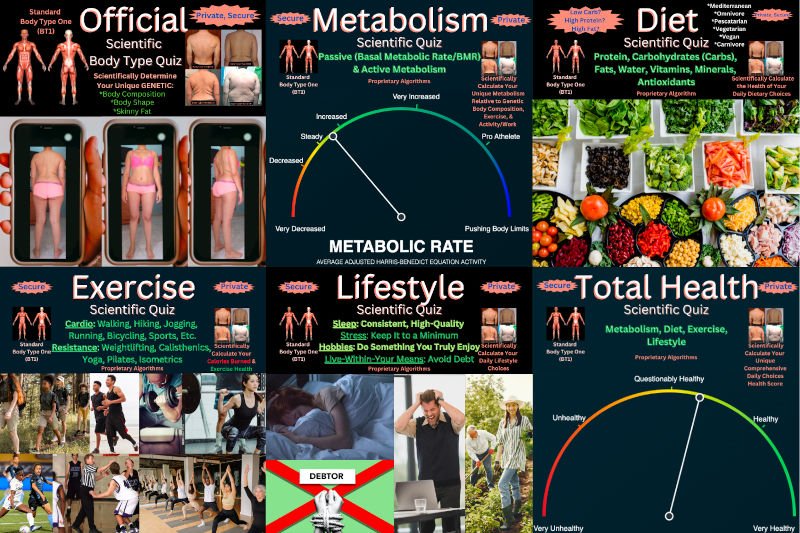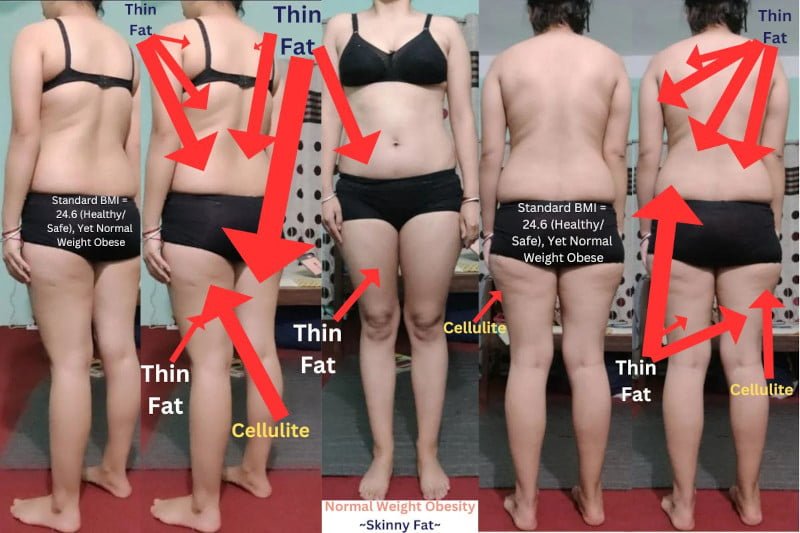Why BMI Fails Skinny Fat Bodies

The Body Mass Index (BMI)(1, 2, 3) is the current scientific standard that medical doctors use to determine basic body composition in terms of too much (BMI 25+) regular white/yellow body fat, or too little (BMI 18.49 or less). But, BMI cannot measure health, nor can it measure how much muscle tissue a person has or does not have (skinny fat), in any instance. In fact, at present, there is no way for science/medicine to accurately measure muscle tissue, genetic or added via resistance/exercise. And there is no average amount of genetic muscle tissue to compare such a measurement to, even if it did exist. Just as there is no way to track added muscle mass or muscle tissue loss from atrophy or sarcopenia (aging).

It is universally grossly assumed that all human beings are born with the same general amount of genetic muscle tissue relative to height and gender. There is zero science to support or prove this common false claim.
The main reason that BMI fails people with skinny fat bodies is, people who are experiencing skinny fat — a lack of genetic muscle (4, 5, 6) — are not experiencing too much regular white/yellow body fat when within safe BMI (there is no science to support this widespread false claim, please comment below with evidence otherwise). Instead, they are experiencing a lack of genetic muscle — which BMI cannot measure — in the form of thin fat and/or cellulite (types of skinny fat (5)) that exist where genetic muscle tissue should be, but is not.
Why BMI Fails Skinny Fat Bodies
Poor diet, exercise, and lifestyle can cause muscle tissue loss, which can make any existing skinny fat (lack of genetic muscle) worse. But muscle tissue cannot turn (7) into fat tissue, or vice versa. This is not how human tissue works. Yet, the initial 2016 NIH skinny fat definition of normal-weight obesity (8, 4) grossly implies that, due to poor diet, exercise, and lifestyle choices, a person has lost muscle tissue, and in place of that lost muscle is too much regular white/yellow fat even when within safe/normal BMI (18.5 to 24.99). Regardless that it directly violates (4) the Standard BMI definition while being backed by no real-world science based on real human beings.

How can medical doctors, or anyone, accurately determine no less than each person’s healthy weight, metabolism, or overall health, let alone body composition and shape, if they cannot accurately measure muscle tissue or track it over time? They cannot. Without knowing each person’s specific muscle tissue measurement, there is no way to accurately know their metabolism, how many calories (BMR/TDEE) their unique body requires, or really even what a healthy weight is for their unique body. Relying solely on the Standard BMI is inaccurate at best, as it cannot discern skinny fat (lack of genetic muscle) or excess muscle tissue, at least.
However, having no standard(s) is not the answer. The solution is to improve the existing Standard BMI. Improvement starts with developing an accurate total muscle tissue average relative to height and gender. Which our MRI Study (9) is working on.
Diet, Exercise, and Lifestyle – Why BMI Fails Skinny Fat Bodies
Because skinny fat is genetic (a lack of genetic muscle), diet, exercise, and lifestyle can only help so much to reduce skinny fat. Properly adding muscle mass is the best course of action. The problem is, most doctors have accepted the initial rough 2016 NIH definition of skinny fat (8) as the “gospel truth” and, along with the Standard BMI, tell their patients who are experiencing skinny fat that they need to lose more regular white/yellow fat weight.
No matter that the patient is already within safe/normal BMI. When the issue is not too much regular body fat, it is a lack of genetic muscle. This leads to further confusion and frustration, especially if the patient has a healthy diet, exercise, and lifestyle while already successfully and safely losing regular white/yellow body fat to get within normal/safe BMI. Now they are being chided for being skinny fat, which is somehow their fault, even though their BMI is within a safe range. Is it any wonder why the mental health crisis and skinny fat crisis are getting worse?
 We developed the Scientific Health Quizzes using the latest science to give people an accurate way to determine their unique genetic body composition, particularly skinny fat, and shape. Along with the health of their metabolism, diet, exercise, and lifestyle. Free options are available. Accounts of free, private, secure, and anonymous.
We developed the Scientific Health Quizzes using the latest science to give people an accurate way to determine their unique genetic body composition, particularly skinny fat, and shape. Along with the health of their metabolism, diet, exercise, and lifestyle. Free options are available. Accounts of free, private, secure, and anonymous.
References
- Cleveland Clinic: Body Mass Index (BMI), May 9, 2022. https://my.clevelandclinic.org/health/articles/9464-body-mass-index-bmi
- MedicalNewsToday: BMI calculator, charts, and categories, November 8, 2024, The MNT Editorial Team (Medically reviewed by Jared Meacham, PhD., RD, CSCS). https://www.medicalnewstoday.com/articles/323586
- Wikipedia, Body mass index. https://en.wikipedia.org/wiki/Body_mass_index
- Skinny Fat Science: Skinny Fat is a Lack of Genetic Muscle – Beyond Normal-Weight Obesity, August 13, 2025. https://skinnyfat.fellowone.com/skinny-fat-science/skinny-fat-is-a-lack-of-genetic-muscle-beyond-normal-weight-obesity/
- Skinny Fat Science: What Is Skinny Fat?, July 26, 2024. https://skinnyfat.fellowone.com/skinny-fat-science/what-is-skinny-fat/
- Skinny Fat Science: Is Muscle/Mass Genetic and How Does It Affect Skinny Fat?, November 20, 2024. https://skinnyfat.fellowone.com/skinny-fat-science/is-muscle-mass-genetic-and-how-does-it-affect-skinny-fat/
- Skinny Fat Science: How To Fix Skinny Fat, July 27, 2024. https://skinnyfat.fellowone.com/skinny-fat-science/how-to-fix-skinny-fat/
- NIH, National Library of Medicine: Normal-weight obesity syndrome: diagnosis, prevalence, and clinical implications, September 2016 (Epub Jul 29, 2016), Lana P Franco, Carla C Morais, Cristiane Cominetti. https://pubmed.ncbi.nlm.nih.gov/27473199/
- Skinny Fat Science: Scientific Skinny Fat MRI Study – Proving What Skinny Fat Is, March 26 2025. https://skinnyfat.fellowone.com/skinny-fat-science/scientific-skinny-fat-mri-study-proving-what-skinny-fat-is/











